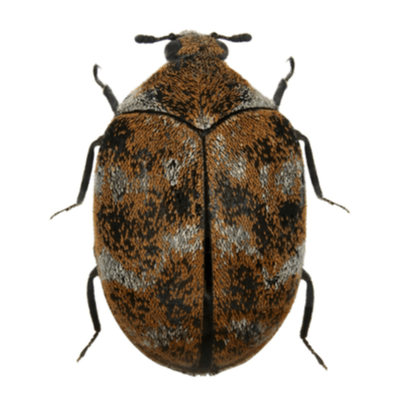
Color: AdultsPattern of white, brown and yellow scales on the upper surface of their wing covers, or elytra.
Size: Mature Larvae are rarely more than 1/4-inch long and bear two pairs of hair tufts on the back end of the abdomen.
Varied carpet beetle larvae are scavengers. They are quite common in nests of birds and spiders, on dead animals, in insect collections, in attics, Oriental carpets, tapestries and wood-based wall-to-wall carpeting.
Fabric pests such as carpet beetles, although not particularly dangerous, can sometimes cause irreparable damage to personal belongings. These beetles are able to digest animal hairs and, therefore, feed on almost any item made of natural fibers, particularly wool and cashmere.
They feed on variety of animal products, such as woolen fabrics, hides, feathers, hair silks, horns, bone and insect pupae. They will feed on dead insects such as flies and have also been found in drywood termite workings after fumigation has killed the termites, or even subterranean termites galleries after soil or bait treatments have done likewise.
Varied carpet beetles feed on dead insects, but also feed on upholstery and carpet, so they can damage those materials. They can also damage clothing fabric.
- In closets, store natural fiber clothing items by covering them with individual plastic covers.
- Use mothballs to help deter fabric pests, but be aware that they may leave an odor that could require dry cleaning.
- Prior to storage, clean woolen and natural fiber clothing according to the manufacturer's instructions.
- Consider storing clothing in large zippered plastic units.
- Do not store boxes of clothes in the attic, garage or basement, if possible.
- If clothing stored in boxes, boxes must be clean thoroughly before storage and seal all corners and openings with tape.
Manufacturer Recommended Products And Treatment For Carpet Beetle Control
Pests need food, water, and shelter. Often the problem may be solved just by removing these key items. Before even thinking about chemical pest control, it is important to be aware of
| Conducive Condition | Recommendation | |
| 1 | Tree branches on house | Keep tree branches away from house to reduce pest access |
| 2 | Firewood next to foundation | Keep firewood away from house to reduce pest harborage |
| 3 | Debris on crawlspace/next to foundation | Remove wood debris to reduce termite ha rborage area |
| 4 | Excessive plant cover, stump, etc. | Providing spacing between plant cover and structure |
| 5 | Soil above the foundation Ii ne | Keep soil below top of foundation to reduce harbo rage areas |
| 6 | Wood-to-ground contact | Keep soil from touching wood to eliminate termite access |
| 7 | Debris on roof/full gutter | Keep gutter & roof free of debris to reduce insect harborage |
| 8 | Standi ng water near/under structure | Eli minate standing water to reduce pest harbo rage |
| 9 | Mo isture problem under structure | Increase ventilation to reduce pest harbo rage area |
| 10 | Openi ngs at plumbi ng & electronics | Seal opening to reduce pest access |
| 11 | Excessive gaps at windows/doors | Seal gaps to reduce pest access |
| 12 | Lea ky plumb ing fixtures | Repair to reduce moisture for pests |
| 13 | Keep garbage cans covered | Covered to reduce attraction of insects of vertebrate pests |
| 14 | Mo isture damage wood | Repair rotten or damaged wood to reduce insect harborage |
| 15 | Grocery bags stored improperly | Seal paper sacks in containers to reduce i nsect ha rborage areas |
| 16 | Pet food unsealed or left out | Keep pet food in sealed containers and unavailable to pests |
| 17 | Excessive storage conditions | Keep storage areas uncluttered and manageable |
| 18 | Debris below kick plates | Remove kick plates to reduce rodent harborage |
1 product


